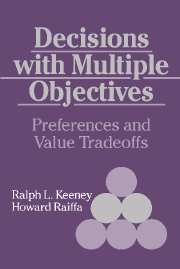Book contents
- Frontmatter
- Contents
- Preface to the Cambridge University Press Edition
- Preface to First Edition
- 1 THE PROBLEM
- 2 THE STRUCTURING OF OBJECTIVES
- 3 TRADEOFFS UNDER CERTAINTY
- 4 UNIDIMENSIONAL UTILITY THEORY
- 5 MULTIATTRIBUTE PREFERENCES UNDER UNCERTAINTY: THE TWO-ATTRIBUTE CASE
- 6 MULTIATTRIBUTE PREFERENCES UNDER UNCERTAINTY: MORE THAN TWO ATTRIBUTES
- 7 ILLUSTRATIVE APPLICATIONS
- 8 AIRPORT DEVELOPMENT FOR MEXICO CITY: A CASE STUDY
- 9 PREFERENCES OVER TIME
- 10 AGGREGATION OF INDIVIDUAL PREFERENCES
- Bibliography
- Index
Preface to First Edition
Published online by Cambridge University Press: 05 July 2014
- Frontmatter
- Contents
- Preface to the Cambridge University Press Edition
- Preface to First Edition
- 1 THE PROBLEM
- 2 THE STRUCTURING OF OBJECTIVES
- 3 TRADEOFFS UNDER CERTAINTY
- 4 UNIDIMENSIONAL UTILITY THEORY
- 5 MULTIATTRIBUTE PREFERENCES UNDER UNCERTAINTY: THE TWO-ATTRIBUTE CASE
- 6 MULTIATTRIBUTE PREFERENCES UNDER UNCERTAINTY: MORE THAN TWO ATTRIBUTES
- 7 ILLUSTRATIVE APPLICATIONS
- 8 AIRPORT DEVELOPMENT FOR MEXICO CITY: A CASE STUDY
- 9 PREFERENCES OVER TIME
- 10 AGGREGATION OF INDIVIDUAL PREFERENCES
- Bibliography
- Index
Summary
If we wanted the title of this book merely to convey the subject matter, it would be some horrendously complicated concoction such as: “On Cardinal Utility Analysis with Multiple Conflicting Objectives: The Case of Individual Decision making Under Uncertainty from the Prescriptive Point of View—with Special Emphasis on Applications but with a Little Theory Thrown In for Spice.”
Our actual title, Decisions with Multiple Objectives: Preferences and Value Tradeoffs is longer than we think a title should ideally be, but, unfortunately, it is too short to prevent unjustified sales. Even in such a simple case, it is not so easy to balance among the conflicting objectives: convey the subject matter, minimize the length, and promote justified sales but prevent unjustified ones.
To an ever growing circle of people, “Decision Analysis” has carved out for itself a niche in the literature of operations research, Systems analysis, management sciences, decision and control, and cybernetics. Decision analysis looks at the paradigm in which an individual decision maker (or decision unit) contemplates a choice of action in an uncertain environment. The approach employs systematic analysis, with some number pushing, which helps the decision maker clarify in his own mind which course of action he should choose. In this sense, the approach is not descriptive, because most people do not attempt to think systematically about hard choices under uncertainty. It is also not normative since it is not an idealized theory designed for the superrational being with an all-powering intellect. It is, instead, a prescriptive approach designed for normally intelligent people who want to think hard and systematically about some important real problems.
- Type
- Chapter
- Information
- Decisions with Multiple ObjectivesPreferences and Value Trade-Offs, pp. xv - xxPublisher: Cambridge University PressPrint publication year: 1993

